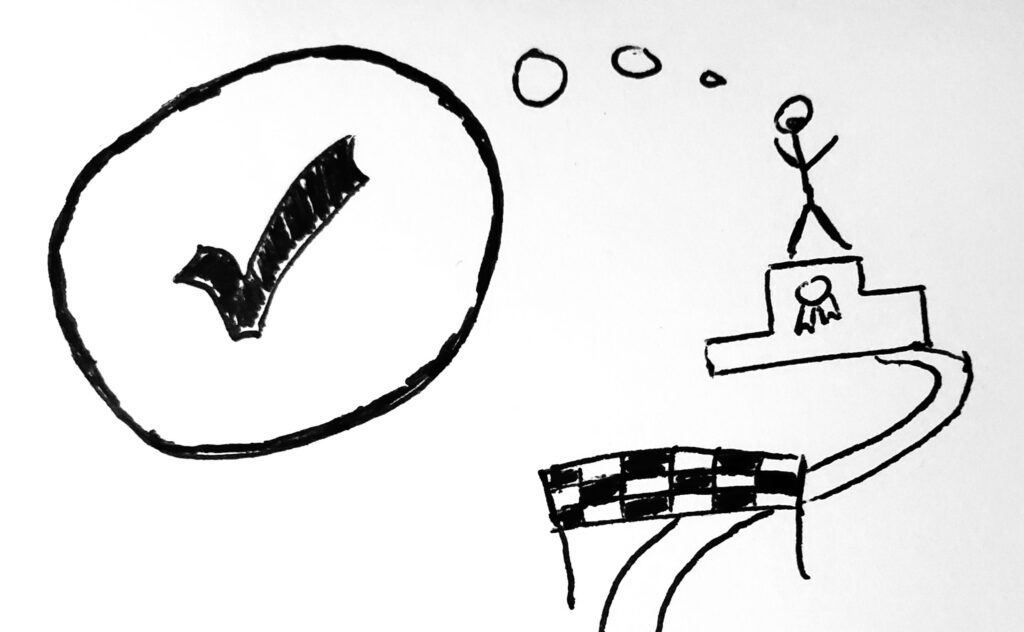Making Anki cards can be a daunting task. It’s time consuming and hard to know where to start and how to make efficient flashcards that will help you remember information quickly and effectively. In this article, I’m going to provide you with the step-by-step process for how I used Anki to memorize 5,000 new vocab words in 6 months while spending the minimum possible time creating new cards.

This article covers a strategy for intermediate/advanced learners or language learners who are on their 2nd or 3rd language, and already understand the process of language learning. I do NOT recommend this strategy to most students if you are just beginning to learn your first foreign language or are new to Anki. This strategy works best for Anki users who already have a basic understanding of the platform.
The strategy I describe here is for massive consumption at a fast pace, therefore Anki purists may accuse me (rightly so) of violating a key tenet of Ankification: first understand, and then Ankify. However, I have to tell you that this method is extremely time-efficient and has allowed me to become conversationally fluent in a new language in a matter of months.
What is Anki and how does it work
First, what is Anki?
If I’ve already lost you, Anki is a spaced-repetition system (SRS) program that helps you memorize information quickly and effectively. Anki works by displaying a question on one side of a card, and the answer on the other side. As you review the answer cards, you can rate how well you know the answer, which helps Anki track how well you are learning the material. The full benefit of Anki lies in the algorithm’s ability to understand how well you know each card and space out when it next quizzes you. I won’t cover the full benefits in this article, but you can check out more resources here (linked). Also, if you’re just learning what an incredibly powerful tool Anki is, then I recommend you start with this strategy (linked).
How to make efficient flashcards
So how do you make Anki cards efficiently? The answer is simple: by understanding how your brain works, and taking advantage of its natural tendencies. By using a combination of text, audio, and images, you can create richer memories that will lead to improved retention and recall. Additionally, by actively improving your cards, you are ensuring that you are engaged in the process of learning, which will lead to even better results down the line.
Just like Anki is efficient by minimizing the number of times you need to review material, you should also be efficient by minimizing the amount of information you put on your cards.
This is true in two different ways, one that is always true and one that is especially true for learning at scale:
- Follow the minimum information principle – every card should have one and ONLY one answer. Separate cards for separate information.
- Follow the minimum time principle – Maximize your ROT (return on time) by spending the minimum time creating cards.
Basic cards can always be improved later as you review them, and that translates into efficiency for bulk learning.
If I have your attention, let me explain my process.
Start by compiling a list of all the material you want to memorize
For most situations, learning by memorizing vocab lists is difficult simply because it’s a dull, rote activity, but also because you’re not making active connections between words in your mind as you consume them.
By connections, I’m talking about engaging the senses to attach to an experience to a word – memories, images, sounds, smells, feels, or tastes.
My solution is to hijack the traditional list-memorizing process and create connections only as necessary, in order to achieve the maximum retention with the fewest connections possible. This allows me to learn basic cards with new words fast.
To do this, find a premade deck with a significant number of words and phrases (at least several hundred, if not several thousand). The best premade decks for this kind of learning are frequency lists that contain the most frequently used words and phrases. There are loads of shared decks uploaded by Anki users on the official site.
While I have been learning Macedonian I have used these shared decks to supplement my own cards I’ve made through immersion, daily life, reading, and language classes.
For example, this one deck has common verbs, nouns, and parts of speech which is presented at an atomic level: MK-EN Vocab
I also have these two large Anki decks which have common phrases, which helps me create more neural connections between what I’m learning and also get a feel for the rhythm of the language: Neri’s Speak and Read (part 1 and part 2)
Identify your sources of truth
Before you start, figure out good reference sources for new words. Even the best pre-made decks will not be perfect, and you need to be able to cross-reference your sources.
I use Wiktionary.com in addition to a local dictionary in my target language. For Macedonian, that has been DRMJ.eu.com. Both of these are easy for me to screenshot on mobile and quickly modify my Anki cards.
I have both of these sources shortcutted on my phone’s homescreen right next to my Anki shortcuts to maximize my efficiency.

If possible, it’s also really great to be able to ask a real-live native speaker your questions. Check out my article about getting a language parent instead of a language partner. You can also use online resources like iTalki where you can pay for online interaction with native speakers.
Begin Reviewing the Basic Cards
Since this was a new deck of pre-made flash cards, you should expect that most of these cards you will not know during the first exposure and will therefore get them wrong in Anki. For this method, that’s ok!
As you go through your second round of reviews, you will naturally remember some cards without much effort. That’s great! That means that you were extremely efficient with your studying for that word or phrase.
If not, this is where we begin to modify the cards to make them “stickier” in our minds.
One of the reasons I like using pre-made decks is because they give you a really solid starting point for your own cards.
This next step is how we make our cards more efficient so that we can learn them in less time, and with less effort.
You’re going to take the words or phrases that you’re still having trouble with, and you’re going to improve those cards by adding more connections.
You can do this in a number of ways, but I’m going to give you some suggestions from my own experience.
Scale the ladder of neural connectivity
Like I mentioned earlier, the more senses you have engaged in your experience of a word, the easier you will be able to remember it.
If I don’t remember a card the 2nd time I see it, then it’s time for me to improve the card. Every time I don’t fully remember the card, I improve the card again until I have a card that I remember and is lodged firmly in my mind. Following this sequence allows me to learn words on-the-go with the minimum number of touches.
If I don’t remember the correct answer for a particular card when I see it a second time, then I need to attack the meaning from different angles, such as…
- Improve the card by adding an image, or
- Change how the information is presented.
- Try to find a sentence example using the word so that I can create more context for myself.
- Find a real-life situation in which I could use the word. Even better!
The more senses that are engaged, the easier it will be to remember.
Anki allows you to do all of these things easily and efficiently. And by improving your cards little by little, you’ll have a highly effective deck with the least time spent writing cards!
Here are the steps I take sequentially with every card that I need to improve. I perform these edits live during my review sessions, and find that even the act of looking up new information and adding it into existing cards helps me use Anki effectively to create memories.
1. Look up the definition on Wiktionary
To move the fastest, I use my phone shortcut to look up the word on Wiktionary, screenshot the definition and any usage notes, and paste that into the card while I have it up on my reviews.
This gives me a great base to start from, and if I can remember the definition while I’m looking at it then that’s fantastic!
I have now added a new level of difficulty by forcing my brain to read the definition and try to understand it while also trying to remember the word. This is how you make Anki cards work FOR you and not AGAINST you.
This is how I looked up the definition for the word “мота” in Macedonian on Wiktionary:

You can see how this would be really helpful if you’re starting from scratch with a new language. Even if you don’t know the word, you can see how it’s used in a sentence.
By the way, if you’re interested in other resources on how to learn a language effectively, I recommend reading Fluent Forever by Gabriel Wyner – it’s a good resource for understanding the mechanics of language learning and how your mind consumes information.
2. Search the word on Google Images – Add an image
Screenshot or download a picture that stands out to you. Add that into the card above any text definitions so that it’s the first thing you see.
This will help you form a connection in your mind between the word and the image.
It also helps if the image is particularly striking or memorable – I find that images with people tend to work well for me, but experiment and see what works best for you!
You might be wondering how this could possibly help you make an Anki deck more efficiently.
The answer is simple: by understanding how your brain works, you can take advantage of its natural tendencies to learn information more effectively. By connecting the foreign word to the concept in your mind instead of to the word in your native language, you’re effectively creating a new memory for the word that is much more likely to be recalled.
It’s also worth noting that you don’t necessarily need to find the “perfect” image.
I often just search for a word and then scroll through the images until I find one that works well enough – it doesn’t need to be perfect, as long as it’s helpful.
Here’s the image I used for “пие” which means “to drink”:

As you can see, it’s not the most exciting image in the world, but it’s helpful and that’s what matters.
3. Add pictures with a headline or caption
If you’re still having trouble after the first image, use Google Image search again but this time add images with a complete phrase or sentence in your target language which contains the flashcard word.
This also helps when you have cards that are similar and you need to be able to distinguish between them. For example, the Macedonian words for “to con, dupe, or hoodwink” and “to recover from an illness” are really close:
Прелажува (pre-LAH-zhu-va)
and
Прележува (pre-LAY-zhu-va)
If you just saw the words as they are written, you might have a hard time differentiating between these two. However, if you see how they’re used in a sentence with surrounding context, it becomes much easier:


This is how I learn best, and how I’ve been able to learn vocabulary quickly using Anki while limiting the amount of time I spend making cards.
4. Delete text definitions and keep only images
If you get to this point, you should have failed several rounds of reviews, so the mental image of the definition in your native language should be attached to whatever image you have added, even if only weakly. The act of forcing yourself to recall the definition based on the image will create a lasting neural connection. Now you just need to attach the foreign word or phrase to the image.
The next step is to delete the text definitions completely and just keep the image. This will force your brain to make the connection between the foreign word/phrase and the image, rather than relying on a crutch.
If you can still remember the definition after doing this, great! That just means that the connection is even stronger.
5. Draw your own image, and consider deleting everything else
Now it’s time for the big guns. Very few cards will be so difficult that you need to do this, however for particularly pesky cards, I will literally go back to the drawing board and create my very own pen or pencil sketches to illustrate a card.
This process is sure to engage multiple senses as you draw on memories and past experiences to illustrate your card. The act of creation will also serve as a powerful memory device.
By this point you should have a card that is engaging multiple senses, has been personally created by you, and contains very little extraneous information. This card will now be much easier to remember during your review sessions.
Here’s an example I drew for the Macedonian verbal prefix “до-“

донесе “bring”, дополни “fill in”, доближи “approach”, дознае “find out”, допише “write in; add to a text”, се допишува “correspond; write”
Spaced Repetition on Steroids
Spaced repetition on it’s own is already extremely powerful to help you learn vocabulary, but if you want to make the most out of your Anki sessions, it’s important to understand how your brain works.
By following the funnel system and making progressively more complex cards, you can take advantage of your brain’s natural tendencies to learn information more effectively. This will help you save time in the long run by reducing the amount of time you need to spend reviewing cards.
By using a combination of text, audio, and images, you are engaging more senses in the experience of learning the word. This creates a richer memory trace in your mind, which will lead to improved retention and recall.
Additionally, by adding images and audio to your cards, you are providing yourself with additional context clues that will help you remember the word more easily.
If you can remember the definition of a word while also looking at an image of it, then you are well on your way to creating efficient Anki cards that will help you learn more effectively.
Finally, by taking the time to improve your cards, you are actively engaged in the process of learning. This active engagement will lead to improved retention and recollection down the line.
Anki is an extremely powerful tool for remembering information. By following the tips in this article, you can make Anki cards more efficiently and increase your chances of remembering the information you study. Whether you need to remember a word or phrase in a foreign language, or just want to be more efficient with your studying, these tips will help you get the most out of Anki. Thanks for reading!
Do you have any tips for how to make good Anki flashcards? Share them in the comments below! And be sure to check out my other articles on how to use Anki effectively. Happy studying!



